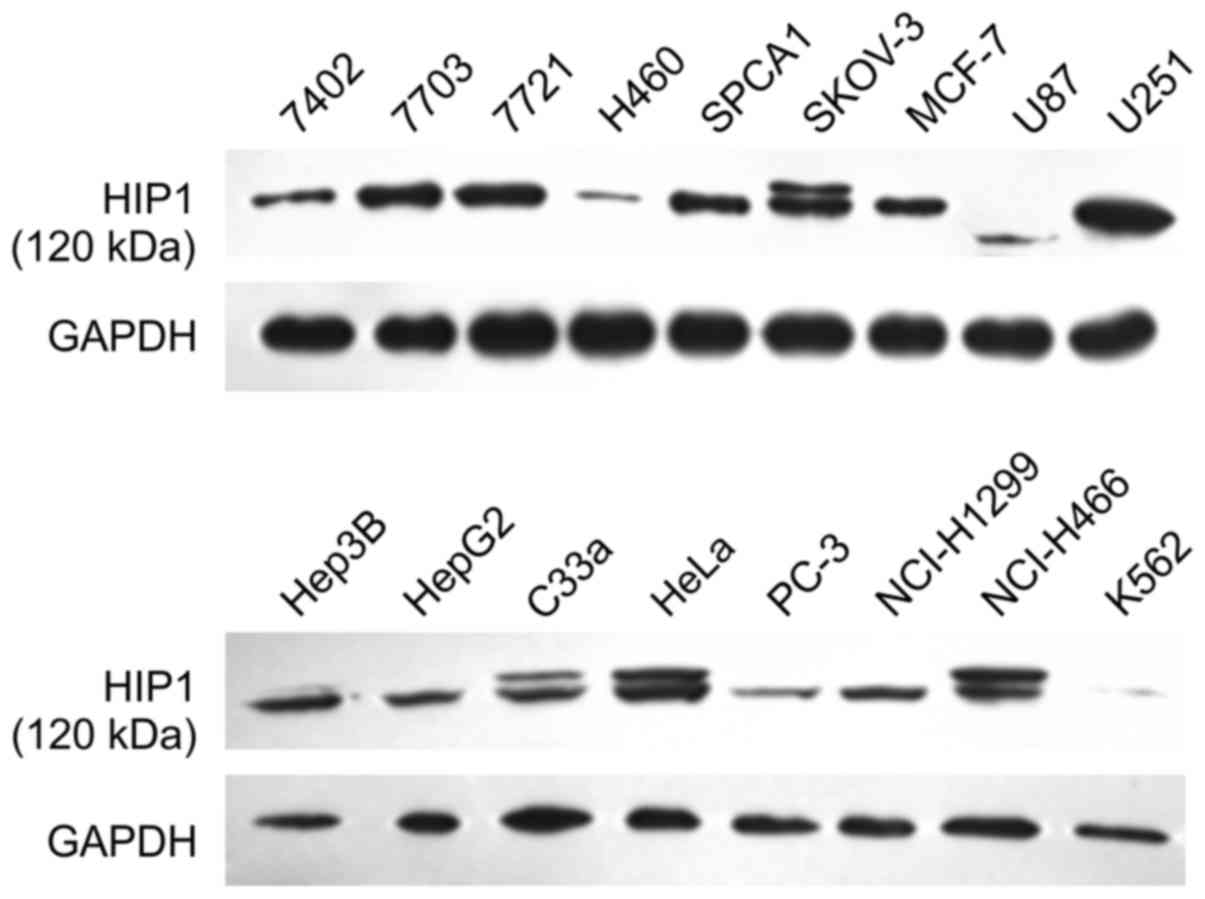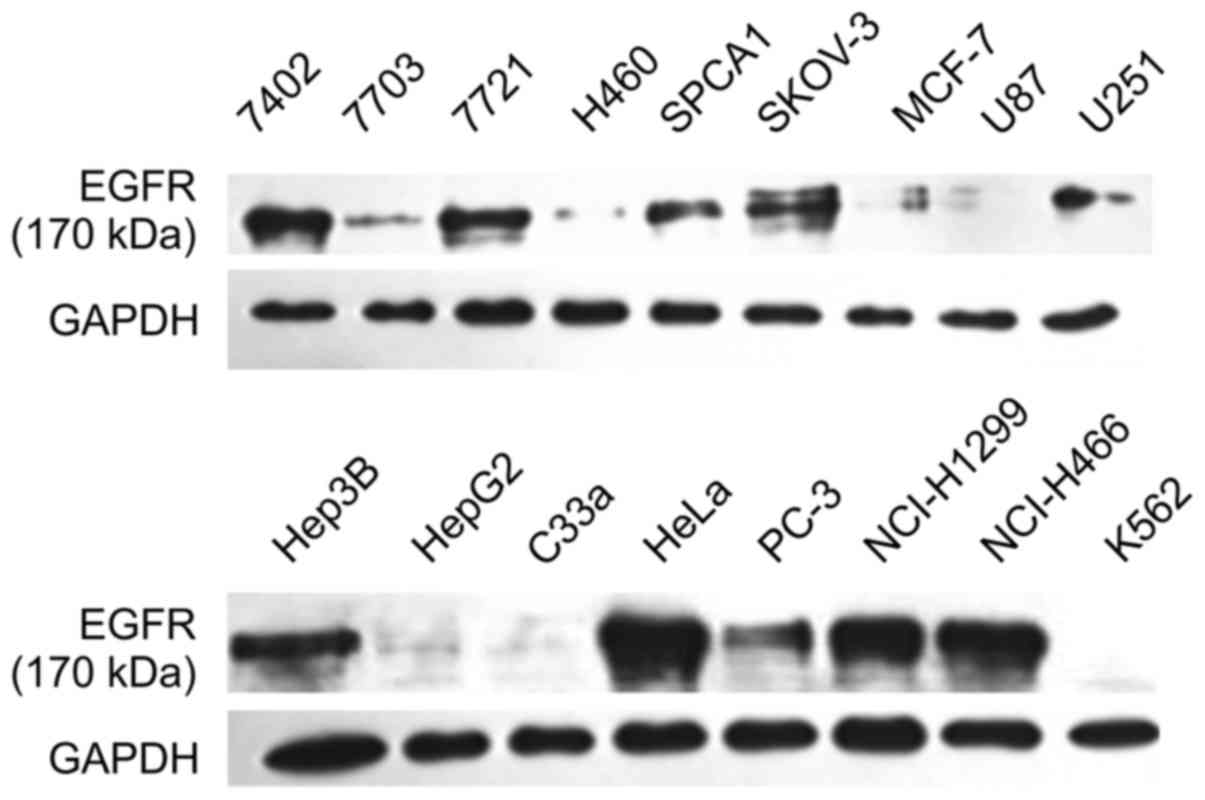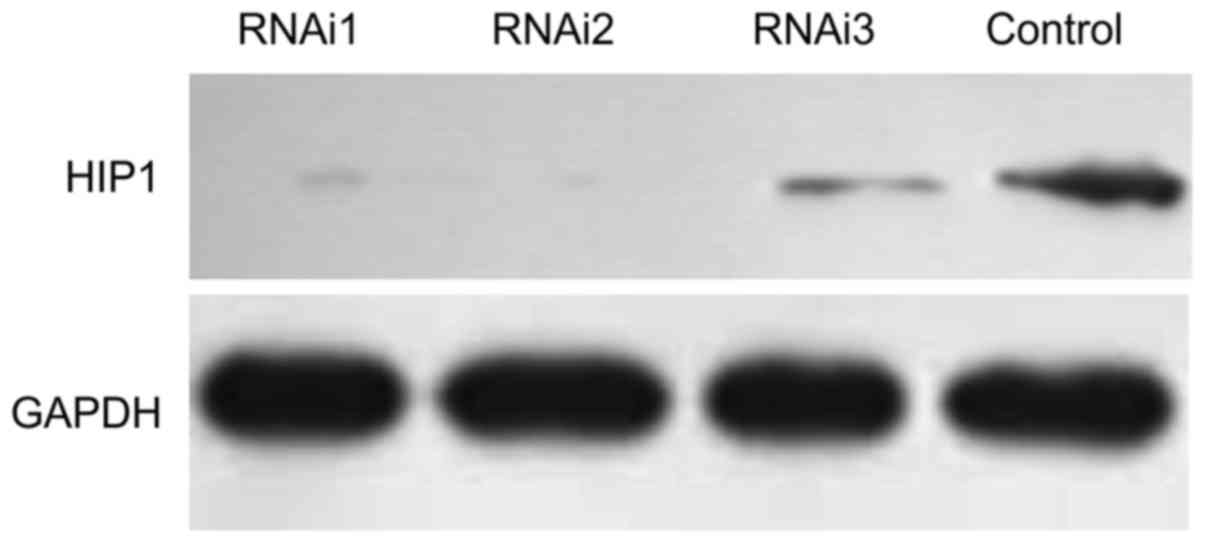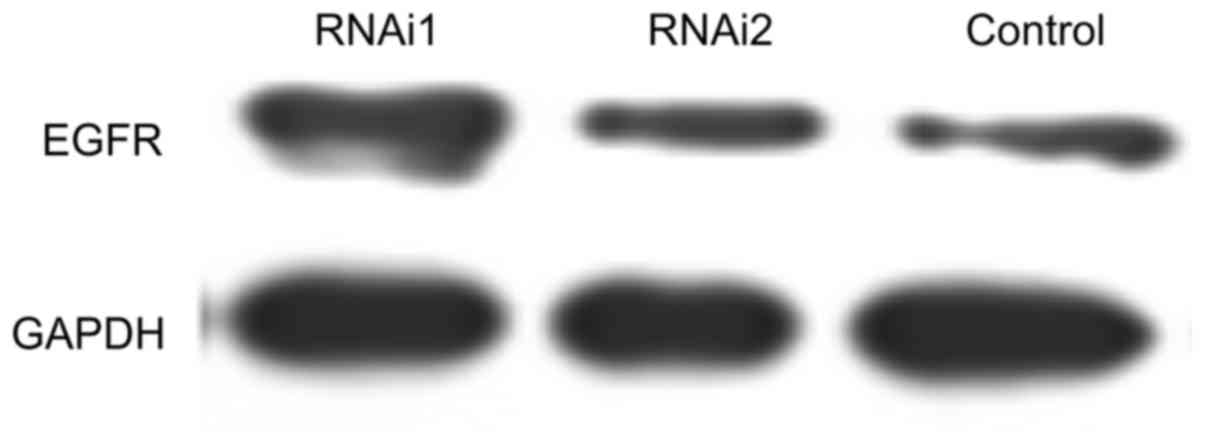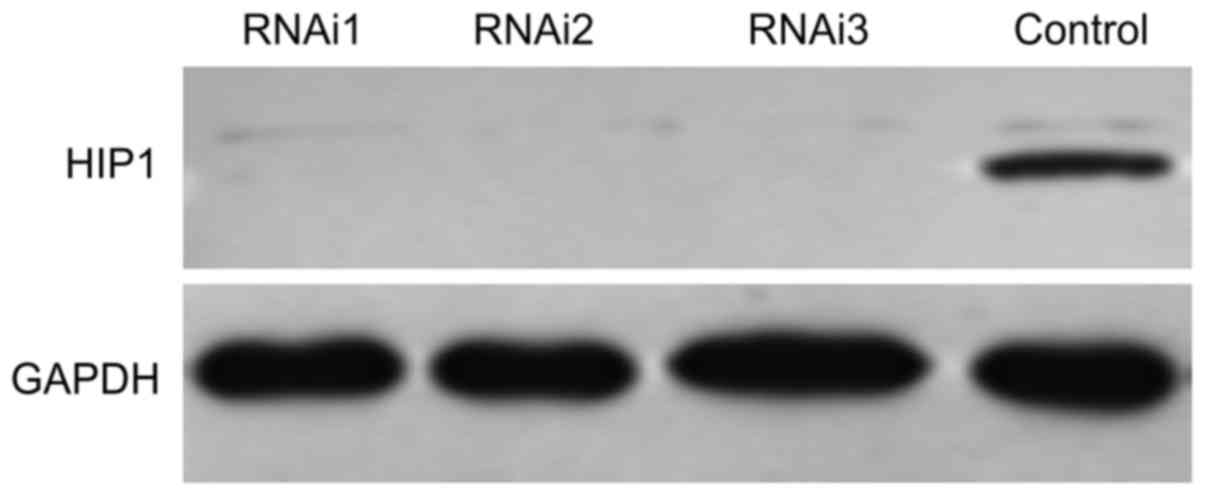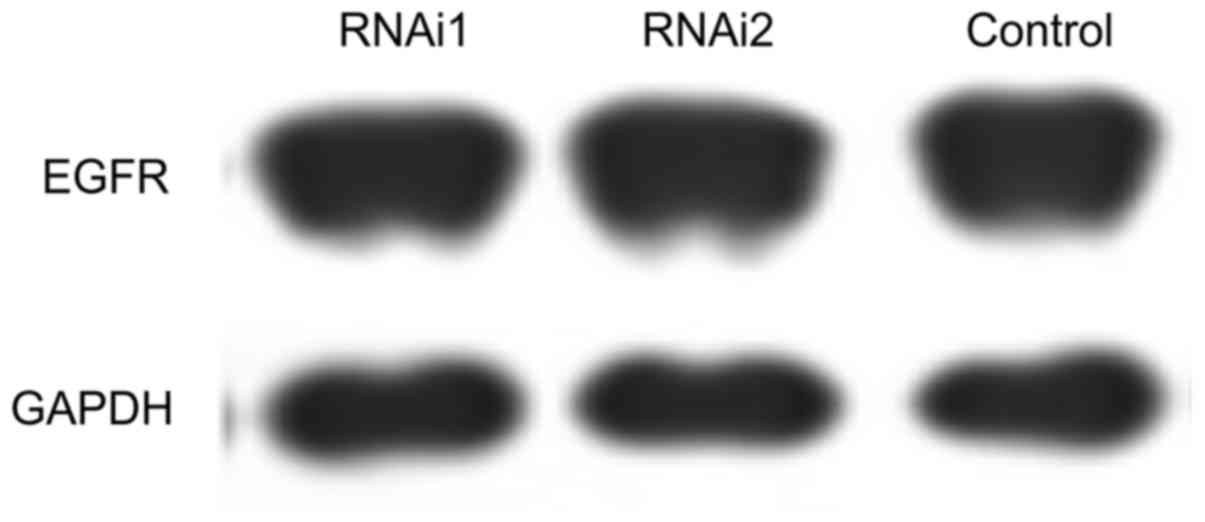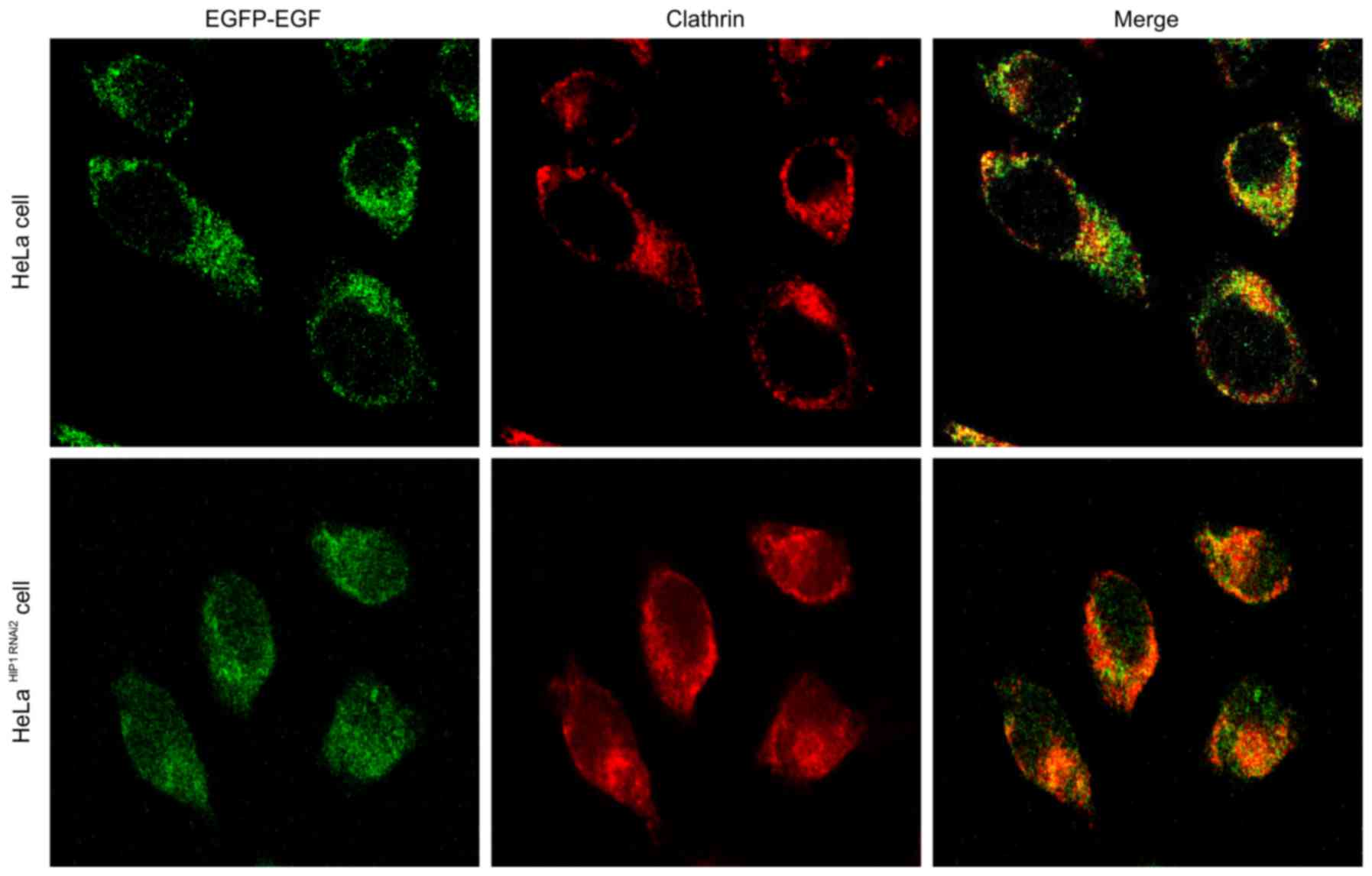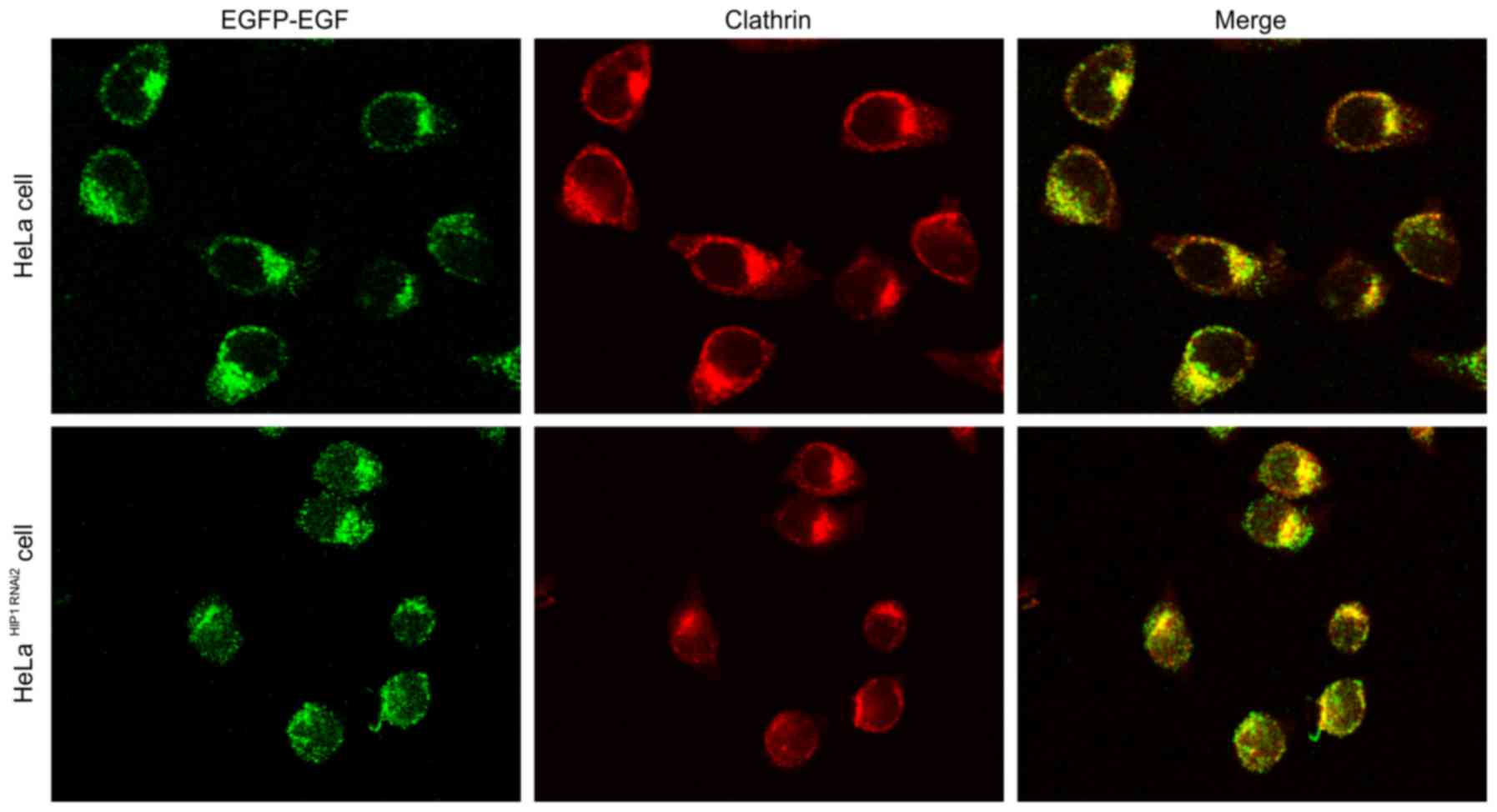Knockdown of HIP1 expression promotes ligand‑induced endocytosis of EGFR in HeLa cells
- Authors:
- Published online on: October 12, 2017 https://doi.org/10.3892/or.2017.6025
- Pages: 3387-3391
-
Copyright: © Li et al. This is an open access article distributed under the terms of Creative Commons Attribution License.
Abstract
Introduction
Huntington-interacting protein 1 (HIP1) was originally characterized using the yeast two-hybrid system in 1997 (1). HIP1 and its only known mammalian homolog HIP1-related (HIP1r) are involved in neurodegeneration based on the finding that HIP1 interacts with the Huntington protein, which is mutated in Huntington's disease, and acts as a component of the endocytic machinery, binding to clathrin, AP2 and actin (2–4).
The overexpression of HIP1 is correlated with brain (5), colon (6), and breast cancers (7). Additionally, HIP1 overexpression in glioblastoma and oligodendroglioma results in a prolonged half-life of growth factor receptors, such as EGFR and PDGF-βR (5). EGFR and its downstream pathways are important for tumor cell invasion and proliferation. The degradation of EGFR is partially achieved by the internalization of activated EGFR and its degradation in lysosomes (8,9).
The stabilization of EGFR levels by HIP1 in cancer cells suggests that HIP1 is related to endocytosis and EGFR degradation, but this relationship has not been definitively established. In this study, the effect of HIP1 on the first step of EGFR endocytosis and the mechanisms by which HIP1 mediates cancer cell proliferation in an EGFR-dependent manner were examined.
Materials and methods
Materials
EGF and Alexa Fluor 647-EGF were purchased from Sigma-Aldrich (St. Louis, MO, USA). Human PKR siRNA (SR303767) and control siRNA (SR30004) were purchased from OriGene (Rockville, MD, USA). The siRNAs against HIP1 were purchased from Ambion (Foster City, CA, USA). Antibodies against clathrin and EGFR were purchased from Abcam (Cambridge, UK). Tetramethylrhodamine isothiocyanate-labeled affinity purified goat anti-mouse IgG and goat anti-rabbit IgG (H+L) were purchased from KPL (Guildford, UK). Electrochemiluminescence kit was bought for Boshide (Wuhan, China). All other chemicals were purchased from Sigma-Aldrich.
Cell culture
Human hepatocarcinoma cells lines 7402, 7703, 7721, Hep3B, HepG2, H460, SPCA1, SKOV-3, HeLa, and MCF-7 and glioma cells U87, U251, C33a, PC-3, NCI-H1299, NCI-H446, and K562 were cultured in Dulbecco's modified Eagle's medium (DMEM) supplemented with 10% fetal bovine serum, 2 mM L-glutamine, and 1X antibiotic-antimycotic solution (15240-096; Invitrogen, Carlsbad, CA, USA) at 37°C in a humidified atmosphere with 5% CO2.
siRNA and transfection
The sequences of siRNAs targeting human HIP1 were as follows: siRNA1, taattgagcgactatacagag; siRNA2, acagcgatatagcaagctaaa; siRNA3, accgcttcatggag cagttta. These siRNAs were designed using siRNA Target Finder developed by Ambion, Inc. Cells were transfected with siRNA using Lipofectamine 2000 (11668-019; Invitrogen) according to the manufacturer's protocol. Transfection was confirmed by an immunoblot analysis.
Western blot assay
Cells were collected, pelleted, and lysed in ice-cold lysis buffer (25 mmol/l Tris-HCl, 1 mmol/l edetic acid, 150 mmol/l NaCl, 50 mmol/l NaF, 1% Triton-100, 1 mmol/l PMSF, 1 mg/l leupeptin, 1 µmol/l aprotinin, pH 7.6). Cell lysates were centrifuged at 4°C and 12,000 g/min, rotated with polyclonal rabbit anti-human antibody for 2 h, followed by precipitation with Protein A Sepharose at 4°C overnight. Beads were washed five times with cold wash buffer (20 mmol/l Tris, pH 7.8, 150 mmol/l NaCl, 1 mmol/l EDTA, 0.1% Triton X-100, 100 µM PMSF and 1 mmol/l Na3VO4) and the bound protein was eluted with Laemmli sample buffer and separated by sodium dodecyl sulfate polyacrylamide gel electrophoresis (SDS-PAGE). After SDS-PAGE, the protein was transferred to a nitrocellulose membrane using a semidry transfer apparatus (Bio-Rad, Hercules, CA, USA), blocked with 3% bovine serum albumin in TBST [10 mmol/l Tris (pH 8.0), 150 mmol/l NaCl, 0.1% Tween-20], incubated at room temperature for 1 h with rabbit anti-human HIP1, EGFR, and GAPDH antibodies, rotated for 1 h at room temperature of 25°C, and washed with TBST three times. The protein on the nitrocellulose membrane was then detected by electrochemiluminescence using a kit with a goat anti-rabbit antibody according to the manufacturer's instructions. Based on the western blotting results, HeLa cells exhibited high coexpression of HIP1 and EGFR and accordingly were used in subsequent experiments.
EGF-EGFR internalization assay
HeLa cells were plated in 6-well dishes and grown to ~50% confluency. After cells were serum-starved for 2 h at 37°C, they were incubated with serum-free DMEM containing Alexa Fluor 647-EGF at a final concentration of 1.5 ng/ml or 100 ng/ml for 1 h at 4°C. Cells were then incubated at 37°C for 1 h to allow internalization. EGFR internalization was stopped by placing the cells at 4°C. The cells were then washed three times for 10 min with PBS, fixed, and permeabilized with 4% paraformaldehyde and 0.1% Triton X-100 in PBS for 10 min. They were then washed with PBS again at room temperature and visualized under a Zeiss LSM confocal microscope (Oberkochen, Germany).
Colocalization assay
EGFR internalization experiments were carried out as described previously. The cells were blocked with 5% normal goat serum in PBS for 30 min, washed three times for 5 min each with PBS, and then incubated with mouse anti-clathrin monoclonal antibody (Abcam) diluted 1:50 in PBS for 3 h at room temperature. After another three washes for 10 min each with PBS, tetramethylrhodamine isothiocyanate-labeled affinity-purified goat anti-mouse IgG and goat anti-rabbit IgG (H+L; KPL) diluted 1:50 in PBS were added and incubated for 30 min. Following a final rinse (3×10 min) with PBS, the cells were visualized under a Zeiss LSM confocal microscope.
Image analysis
Images were collected using a Zeiss LSM510-Meta laser scanning confocal microscope with a 63× water immersion objective. Colocalization was calculated using ImageJ (NIH, Bethesda, MD, USA) with the JACoP plug-in to estimate Manders coefficients with automated thresholding. Statistical analyses were implemented in GraphPad Prism (GraphPad, La Jolla, CA, USA).
Statistical analysis
Based on the image analysis data, differences among treatment groups were examined by analysis of variance (ANOVA). Data are represented as means ± SEM of three experiments. P<0.05 was considered statistically significant. When significant differences were detected, specific post-hoc comparisons between treatment groups were performed using Student-Newman-Keuls tests.
Results
Expression of HIP1 and EGFR in tumor cell lines
Using 17 cell lines, western blotting was performed to identify cells with high expression levels of both HIP1 and EGFR. As shown in Fig. 1, the 7703, 7721, SKOV-3, U251, and HeLa cell lines exhibited higher expression levels of HIP1 than those of other cell lines. As shown in Fig. 2, the Hep3B, HeLa, PC-3, NCI-H1299, and NCI-H466 cell lines had higher expression levels of EGFR than those of other cell lines. Combining these results, the HeLa cell line had high expression levels of both HIP1 and EGFR.
Knockdown of HIP1 in HeLa cells
Based on western blot assays, in HeLa cells, the expression of HIP1 was significantly blocked by siRNA1 (taattgagcgactatacagag) and siRNA2 (acagcgatatagcaagctaaa), both of which were more efficient compared with siRNA3 (accgcttcatggagcagttta) (Fig. 3). Neither siRNA1 nor siRNA2 influenced the expression levels of EGFR and GAPDH in HeLa cells (Fig. 4).
NCI-H1299 cells exhibited high expression of EGFR and low expression of HIP1 (Figs. 1 and 2). Accordingly, NCI-H1299 was chosen as a control to examine the effects of HIP1 siRNA. As shown in Fig. 5, the expression of HIP1 was significantly blocked by siRNA1, siRNA2 and siRNA3. The three siRNAs had no effect on the expression levels of EGFR and GAPDH in NCI-H1299 cells (Fig. 6).
Internalization of EGF-EGFR
After stimulation with 1.5 ng/ml EGF, endocytosis of EGF-bound EGFR was significantly accelerated after the expression of HIP1 was blocked (Fig. 7). After simulation with 100 ng/ml EGF, endocytosis of EGF-bound EGFR was also significantly accelerated after the expression of HIP1 was blocked (Fig. 8). There was no obvious difference between 1.5 and 100 ng/ml EGF with respect to EGFR endocytosis (Figs. 7 and 8).
Colocalization of EGF-EGFR and clathrin
Clathrin-mediated endocytosis was also accelerated after the expression of HIP1 was blocked, and exhibited a positive correlation with the internalization of EGF-EGFR for both 1.5 ng/ml (Fig. 7) and 100 ng/ml EGF (Fig. 8). There was no obvious difference between 1.5 and 100 ng/ml EGF with respect to clathrin endocytosis (Figs. 7 and 8). EGFR and clathrin were colocalized in the cytoplasm.
Discussion
Overactivation of EGFR signaling pathway is strongly associated with carcinogenesis, and it is becoming increasingly clear that impaired deactivation of EGFR may also be a mechanism in cancer. A major deactivation pathway for EGFR downregulation involves ligand-induced endocytosis of EGFR and subsequent degradation in lysosomes; this is important in carcinogenesis, e.g., in breast cancer (8). N-acetylglucosaminyltransferase Va (GnT-Va) is involved in the EGF-induced downregulation of EGFR and intracellular signaling by inhibiting receptor endocytosis. When GnT-Va expression is knocked down in highly invasive human breast cancer cells, ligand-induced downregulation of EGFR expression is inhibited via decreased EGFR endocytosis, resulting in delayed downstream signal transduction and inhibition of EGF-induced invasiveness phenotypes (10,11).
HIP1 may be involved in the endocytosis of EGFR. Previous studies have demonstrated the colocalization of HIP1 and markers of clathrin-mediated endocytosis in neuronal cells and the enrichment of HIP1 on clathrin-coated vesicles purified from brain homogenates (5). HIP1 binds to clathrin adaptor protein 2 (AP2) and the terminal domain of the clathrin heavy chain, predominantly via a small fragment at amino acids 276–335. This region, a clathrin-box, contains consensus clathrin- and AP2-binding sites with high binding affinity to the terminal domain of the clathrin heavy chain and the ear domain of the AP2 subunit, respectively, leading to efficient stimulation of the clathrin assembly via its central helical domain by binding directly to the clathrin light chain (3–5). These results suggest that HIP1 has functional roles in clathrin-mediated endocytosis.
In this experiment, we screened 17 tumor cell lines to identify cells with high expression of both HIP1 and EGFR. HeLa cells had obviously high expression of both HIP1 and EGFR. Various siRNAs were designed to block the expression of HIP1 in HeLa cells to evaluate its inhibitory effects on EGFR endocytosis. Two siRNA sequences (taattgagcgactata cagag and acagcgatatagcaagctaaa, efficiently blocked HIP1 expression. We confirmed these results using NCI-H1299 cells as controls. After the blockage of HIP1 expression and stimulation with 1.5 ng/ml EGF, EGFR endocytosis was significantly accelerated. The same results were obtained after stimulation with 100 ng/ml EGF. The acceleration of EGFR endocytosis was only correlated with HIP1 blockage. HIP1 can stabilize EGFR on cell surfaces by decreasing EGFR endocytosis. This process was correlated with clathrin endocytosis.
In the present study, we explored the role of HIP1 in the degradation of EGFR in cancer cells. This is the first analysis of EGFR and HIP1 coexpression in a large number of cell lines, and our results clearly demonstrated the effects of HIP1 inhibition on EGFR endocytosis. These findings may explain the proliferative and anti-apoptotic effects of HIP1 on tumor cells. HIP1 inhibition can accelerate EGFR endocytosis and degradation. These results also suggest a new method to treat carcinoma with high EGFR expression by targeting HIP1, but additional studies are needed to evaluate the clinical potential.
Acknowledgements
This study was supported by grants from the National Natural Science Foundation of China (81300321), the Key Discipline Foundation of Fujian Province (2012-149), and the Young and Middle-Aged Personnel Training Project of Fujian Province Health Department (2014-ZQN-ZD-9).
Glossary
Abbreviations
Abbreviations:
|
HIP1 |
Huntington-interacting protein 1 |
|
AP2 |
adaptor protein 2 |
|
GnT-Va |
N-acetylglucosaminyltransferase Va |
References
|
Kalchman MA, Koide HB, McCutcheon K, Graham RK, Nichol K, Nishiyama K, Kazemi-Esfarjani P, Lynn FC, Wellington C, Metzler M, et al: HIP1, a human homologue of S. cerevisiae Sla2p, interacts with membrane-associated huntingtin in the brain. Nat Genet. 16:44–53. 1997. View Article : Google Scholar : PubMed/NCBI | |
|
Legendre-Guillemin V, Metzler M, Charbonneau M, Gan L, Chopra V, Philie J, Hayden MR and McPherson PS: HIP1 and HIP12 display differential binding to F-actin, AP2, and clathrin. Identification of a novel interaction with clathrin light chain. J Biol Chem. 277:19897–19904. 2002. View Article : Google Scholar : PubMed/NCBI | |
|
Metzler M, Legendre-Guillemin V, Gan L, Chopra V, Kwok A, McPherson PS and Hayden MR: HIP1 functions in clathrin-mediated endocytosis through binding to clathrin and adaptor protein 2. J Biol Chem. 276:39271–39276. 2001. View Article : Google Scholar : PubMed/NCBI | |
|
Mousavi SA, Malerød L, Berg T and Kjeken R: Clathrin-dependent endocytosis. Biochem J. 377:1–16. 2004. View Article : Google Scholar : PubMed/NCBI | |
|
Bradley SV, Holland EC, Liu GY, Thomas D, Hyun TS and Ross TS: Huntingtin interacting protein 1 is a novel brain tumor marker that associates with epidermal growth factor receptor. Cancer Res. 67:3609–3615. 2007. View Article : Google Scholar : PubMed/NCBI | |
|
Rao DS, Hyun TS, Kumar PD, Mizukami IF, Rubin MA, Lucas PC, Sanda MG and Ross TS: Huntingtin-interacting protein 1 is overexpressed in prostate and colon cancer and is critical for cellular survival. J Clin Invest. 110:351–360. 2002. View Article : Google Scholar : PubMed/NCBI | |
|
Rao DS, Bradley SV, Kumar PD, Hyun TS, Saint-Dic D, Oravecz-Wilson K, Kleer CG and Ross TS: Altered receptor trafficking in Huntingtin Interacting Protein 1-transformed cells. Cancer Cell. 3:471–482. 2003. View Article : Google Scholar : PubMed/NCBI | |
|
Bache KG, Slagsvold T and Stenmark H: Defective downregulation of receptor tyrosine kinases in cancer. EMBO J. 23:2707–2712. 2004. View Article : Google Scholar : PubMed/NCBI | |
|
Rosell R: Cancer and alterations in the endocytic pathway. Future Oncol. 3:487–489. 2007. View Article : Google Scholar : PubMed/NCBI | |
|
Guo HB, Johnson H, Randolph M, Lee I and Pierce M: Knockdown of GnT-Va expression inhibits ligand-induced downregulation of the epidermal growth factor receptor and intracellular signaling by inhibiting receptor endocytosis. Glycobiology. 19:547–559. 2009. View Article : Google Scholar : PubMed/NCBI | |
|
Mutch LJ, Howden JD, Jenner EP, Poulter NS and Rappoport JZ: Polarised clathrin-mediated endocytosis of EGFR during chemotactic invasion. Traffic. 15:648–664. 2014. View Article : Google Scholar : PubMed/NCBI |



